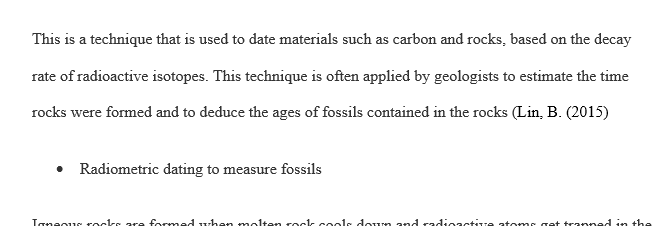How radiometric dating has been utilized
Age is Relative
The question of age can be applied to humans, clothing, food, furniture, and fossils. Doctors study how humans age and can observe how hair turns grey and skin becomes wrinkled. Rocks and other organic materials do not always provide observers the same outward changes. In order to determine the age of a material; including human bones, radiometric dating can be applied. Determining the amount of radioactive isotopes in a geological or archeological specimen can help decipher its relative age. Since all rocks and minerals contain radioactive elements, the decay process is like a clock that a geologist can read since different radioactive elements have independent “clocks” or half-lives. Read more about radiometric dating in your textbook.
For this unit, answer the following questions:
Pick TWO of the following and describe how radiometric dating has been utilized to determine their age:
Earth
Moon
Meteorites
Fossils
Early man
Historic relics (i.e., Dead Sea Scrolls, Shroud of Turin)
Volcanic eruptions
Identify one element used to date rocks and minerals. How long is its half-life?
How can radioactivity be measured?
Rocks, minerals, and even food we eat can contain radioactive material. Why doesn’t this radioactive material comprise a threat to humans?
What is an alternative method to radiometric dating? What are the strengths and weaknesses to this type of dating process?
Solution preview for the order on how radiometric dating has been utilized
